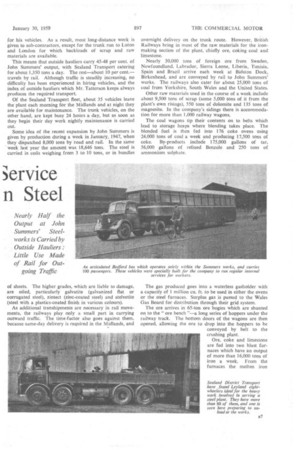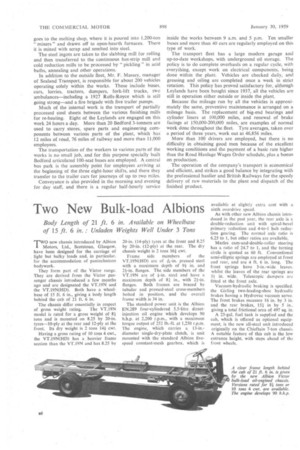Door-to-dooi is Essential "iervice n Steel
Page 144

Page 145

Page 146

If you've noticed an error in this article please click here to report it so we can fix it.
By
G. Duncan Jewell
DAY and night a continuous stream of heavy vehicles leaves the 75-acre plant of John Summers and Sons, Ltd., Hawarclen Bridge, Shotton, carrying steel sheets to all parts of the country. Shipments average between 16,000 and 17,000 tons a week, and to meet everincreasing competition it is essential that door-to-door deliveries are made from Shotton to the customer. Therefore, firm control of the company's transport is vital.
• They decided to operate their own vehicles in the 1930s, forming a subsidiary, Sealand District Transport, Ltd., to do the work. First purchases were Bedfords—larger vehicles could not get into the works because of a low bridge—and by 1936, 12 articulated outfits were being operated. It was soon evident, however, that loads of 12 tons and over were beyond these units. Another point was that articulation was unsatisfactory for the conveyance of heavy loads of steel.
The way became clear for improvements in 1937 when the -bridge problem was removed, and Sealand Transport made a complete changeover to Leyland eight-wheelers. Because they were built locally, which meant good servicing facilities, it was decided to standardize with these vehicles, and another 25 were added to the fleet within the next two years.
An important development took. place in 1955 when two companies inter-connected with John Summers—the Wolverhampton Corrugated Iron Co., Ltd., and British. Coated Sheets, Ltd,—moved to_ Hawarden Bridge. They had 21 Ley/ands and four Bedfords operated by a subsidiary, Great Northern Transport, Ltd., which were 136 absorbed by Sealand Transport when the change occurred.
Nowadays, Sealand Transport have an outside fleet of 85 C-licensed vehicles, all eightwheelers except for one Bedford 6-tormer. Mr. G. K. Tatterson, who has been transport manager for• the past 10 years, divides them into six groups of 13 vehicles, with the remainder kept in reserve. Four groups are employed on day work and two on the trunk routes, with each of the six groups alternating between the two types of 'operation.
John Summers' plant is in full production 24 hours a day from 6 a.m. on Sunday until noon the following Saturday.. On Sunday nights one group of trunk vehicles bound for Luton and the London area leaves the works after being loaded in late afternoon. Another group makes the same journey the following night, and in both cases shunt drivers take over at Oxford and Dunstable.
Meanwhile, the day groups operate over an 80-mile radius, mainly travelling to the Midlands, although export steel is also carried in large quantities to Liverpool, Birkenhead and Ellesmere Port. Automobile manufacturers are the major customers, but substantial deliveries are made to makers of oil drums, kitchen and office furniture, refrigerators, cookers, agricultural implements, outbuildings and-many other commodities. ,
-Sealand Transport's fleet must run as a paying concern; and Mr. Tatterson regards day work as more economical
for his vehicles. As a result, most long-distance work is given to sub-contractors, except for the trunk run to Luton and London for which backloads of scrap and raw materials are available.
This means that outside hauliers carry 45-48 per cent. of John Summers' output, with Sealand Transport catering for about 1,350 tons a day. The rest—about 10 per cent.— travels by rail. Although traffic is steadily increasing, no difficulty has been experienced in hiring vehicles, and the index of outside hauliers which Mr. Tatterson keeps always produces the required transport.
Of the Sealand Transport fleet, about 35 vehicles leave the plant each morning for the Midlands and at night they are available for maintenance. The trunk vehicles, on the other hand, are kept busy 24 hours a day, but as soon as they begin their day work nightly maintenance is carried out.
Some idea of the recent expansion by John Summers is given by production during a week in January, 1947, when they dispatched 8,000 tons by road and rail. in the same week last year the amount, was 18,646 tons. The steel is carried in coils weighing from 3 to 10 tons, or in bundles
of sheets. The higher grades, -which are liable to damage, are oiled, particularly gaIvatite (galvanized flat or corrugated steel), zintect (zinc-coated steel) and stelvetite (steel with a plastics-coated finish in various colours).
As additional transhipments are necessary in rail movements, the railways play only a small part in carrying outward traffic. The time-factor also goes against them, because same-day delivery is required in the Midlands, and overnight delivery on the trunk route. However, British Railways bring in most of the raw materials for the iron making section of the plant, chiefly ore, coking coal and limestone.
Nearly 30,000 tons of foreign ore from Sweden, Newfoundland, Labrador, Sierra Leone, Liberia, Tunisia, Spain and Brazil arrive each week at Bidston Dock, Birkenhead, and are conveyed by rail to John Summers' works. The railways also cater for about 25,000 tons of coal from Yorkshire, South Wales and the United States.
Other raw materials used in the course of a week include about 9,500 tons of scrap (some 5,000 tons of it from the plant's own risings), 550 tons of dolomite and 135 tons of magnesite. In the company's sidings there is accommodation for more than 1,000 railway wagons, The coal wagons tip their contents on to belts which lead to storage heaps where blending takes place. The blended fuel is then fed into 176 coke ovens using 24,000 tons of coal a week and producing 17,500 tons of coke. By-products include 175,000 gallons of tar, 56,000 gallons of refined Benzoic and 250 tons of ammonium sulphate.
The gas produced goes into a waterless gasholder with a capacify of 1 million cu. ft. to be used in either the ovens or the steel furnaces. Surplus gas is passed to the Wales Gas Board for distribution through their grid system.
The ore arrives in 65-ton ore bogies which are shunted on to the " ore bench "—a long series of hoppers under the railway track. The bottom doors of the wagons are then opened, allowing the ore to drop into the hoppers to be conveyed by belt to the crushing plant.
Ore, coke and limestone are fed into two blast furnaces which have an output of more than 16,000 tons of iron a week. From the furnaces the molten iron
goes to the melting shop, where it is poured into 1,200-ton " mixers " and drawn off to open-hearth furnaces. There it is mixed with scrap and smelted into steel.
The steel ingots are taken to the slabbing mill for rolling and then transferred to the continuous hot-strip mill and cold reduction mills to be processed by " pickling " in acid baths, annealing and other operations.
In addition to the outside fleet, Mr. F. Massey, manager of Sealand Transport, is responsible for about 200 vehicles operating solely within the works. These include -buses, cars, lorries, tractors, dumpers, fork-lift trucks, two ambulances—including a 1927 Rolls-Royce which is still going strong—and a fire brigade with five trailer pumps.
Much of the internal work is the transport of partially processed steel sheets between the various finishing mills for re-heating. Eight of the Leylands are engaged on this work 24 hours a day. More than 20 Bedford 3-tonners are used to carry stores, spare parts and engineering components between various parts of the plant, which has 12 miles of road, 76 miles of railway and more than 11,000 employees.
The transportation of the workers to various parts of the works is no small job, and for this purpose specially built Bedford articulated 100-seat buses are employed. A central bus park is the assembly point for employees arriving at the beginning of the three eight-hour shifts, and there they transfer to the trailer cars for journeys of up to two miles.
Conveyance is also provided in the morning and evening for day staff, and there is a regular half-hourly service inside the works between 9 a.m. and 5 p.m. Ten smaller buses and more than 40 cars are regularly employed on this type of work.
The transport fleet has a large modern garage and up-to-date workshops, with underground oil storage. The policy is to do complete overhauls on a regular cycle, with everything, except work on electrical components, being done within the plant. Vehicles are checked daily, and greasing and oiling are completed once a week in strict rotation. This policy has proved satisfactory for, although Leylands have been bought since 1937, all the vehicles are still in operation either outside or inside the plant.
Because the mileage run by all the vehicles is approximately the same, preventive maintenance is arranged on a mileage basis. The replacement of big-end bearings and cylinder liners at 100,000 miles, and renewal of brake facings at 150,000-200,000 miles, are examples of normal work done throughout the fleet. Tyre averages,taken over a period of three years, work out at 46,856 miles.
More than 100 drivers are employed, but there is no difficulty in obtaining good men because of the excellent working conditions and the payment of a basic rate higher than the Road Haulage Wages Order schedule, plus a bonus on production.
The operation of the company's transport is economical and efficient, and strikes a good balance by integrating with the professional haulier and British Railways for the speedy delivery of raw materials to the plant and dispatch of the finished product.




































































































































































































